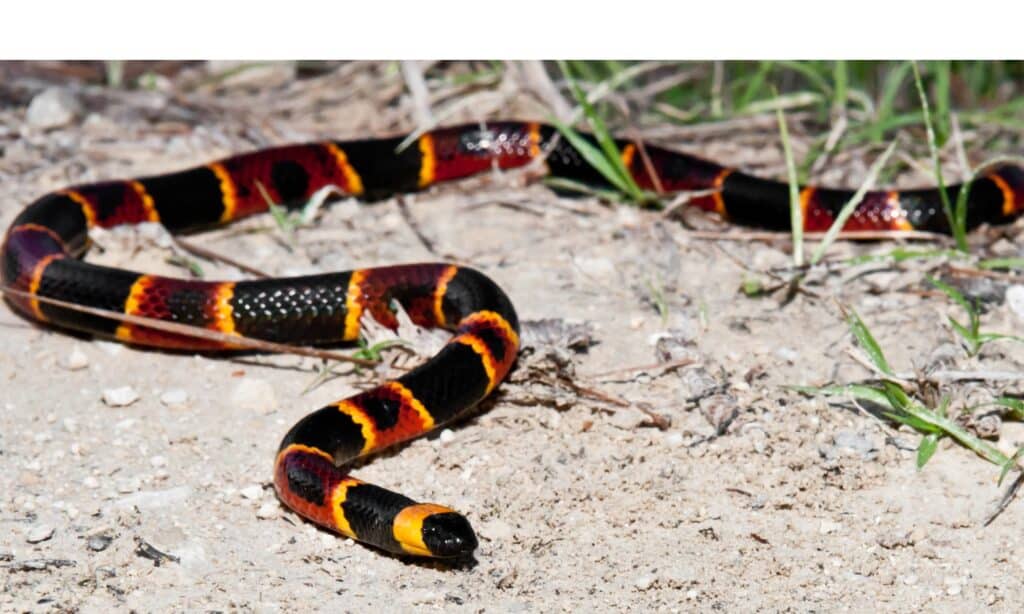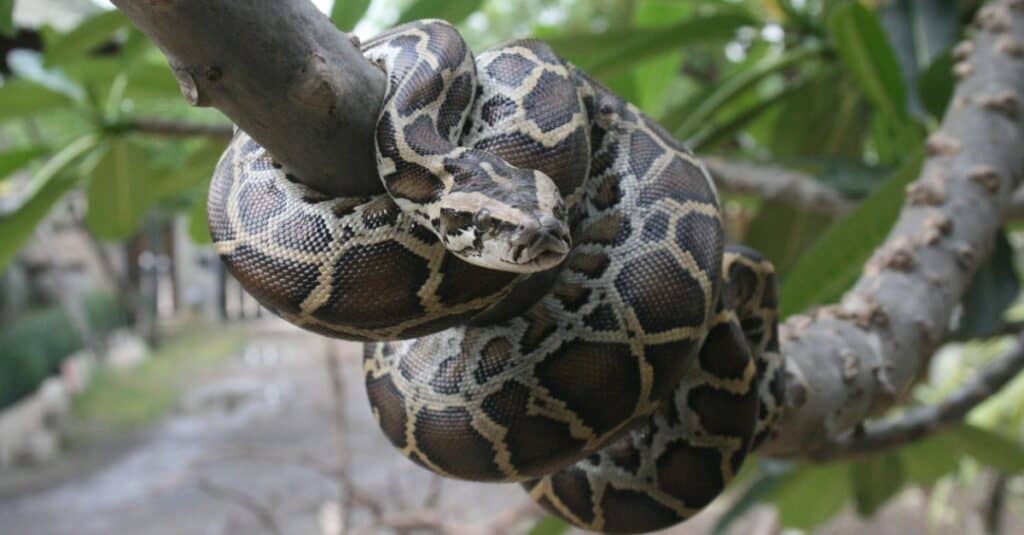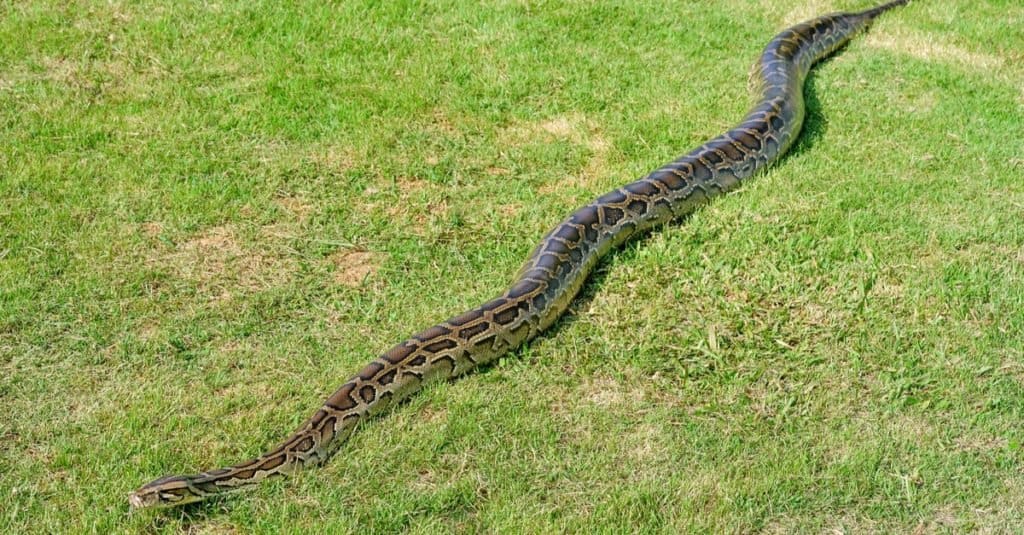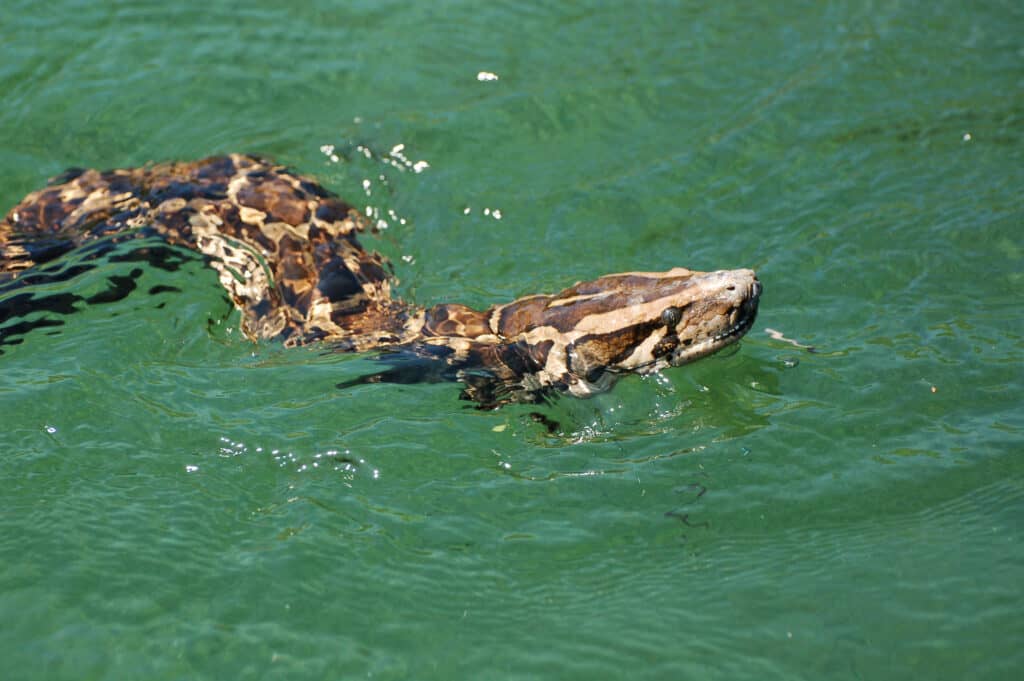The Florida Everglades is home to numerous species of plants, animals, reptiles, amphibians, insects, and more. Everglades National Park encompasses most of the southern third of Florida. The park is made up of a vast tropical wetland ecosystem that’s perfect for big snakes to hide in.
Here, we’ll learn more about just what types of snakes call the Everglades home. Then, we’ll discover the largest snake currently living in this World Heritage Site, as well as news reports of the largest specimen ever found. Then, we’ll take a look at exactly what makes the largest snake found in the Everglades so unique. Finally, we’ll learn whether or not the Everglades’ largest snake really is an invasive species that threatens the entire ecosystem of the park.
What Snakes Live in the Everglades?

There are nearly two dozen species of snake living in the Everglades.
©iStock.com/JasonOndreicka
The Everglades is home to 23 species of snake, four of which are venomous. Among the venomous are the eastern diamondback rattlesnake, dusky pygmy rattlesnake, eastern coral snake, and Florida cottonmouth. The park is also home to boa constrictors, rat snakes, hognose snakes, kingsnakes, water snakes, and garter snakes—none of which are venomous.
No matter what kind of snake you encounter in the Florida Everglades, remember to treat it with respect. Never try to approach or pick up a snake in the wild, regardless of whether or not it seems dangerous. Now, let’s take a look at the largest snake found in the Everglades.
What is the Largest Snake in the Everglades?

The
Burmese
python is the largest snake found in the Everglades.
©asawinimages/Shutterstock.com
The largest snake found in the Everglades is the Burmese python. Burmese pythons can grow up to 20 feet long, and weigh over 100 pounds. Because they survive and reproduce so successfully in the Florida Everglades, they’ve become a real problem over the past four decades. Despite their size, they hide easily in the sawgrass fields and cypress swamps of the Everglades. In fact, they’re so hard to find that professional python hunters are employed to root out and get rid of nuisance snakes.
The Largest Burmese Pythons Ever Found in the Everglades

There are actually several contenders when it comes to the largest Burmese python ever found in the Everglades. In 2012, members of the U.S. Geological Survey killed a 17-foot, 7-inch female Burmese python that weighed nearly 165 pounds. At the time, this was the heaviest snake ever recorded in the Everglades, and she was carrying 87 eggs at the time of death.
Then on June 20, 2022, a 215-pound Burmese python was captured in the Everglades, setting a new record for weight and measuring 18 feet long.
But, that female isn’t the longest snake ever found in the Everglades. That title goes to another female python; this one was killed in 2020 by professional python hunters. This female measured in at 18.9 feet long, though her weight was not recorded.
Profile: The Burmese Python

Burmese pythons are capable of growing up to 19 feet, with females being the larger gender
©iStock.com/Lunatic_67
Burmese pythons are among the largest snakes in the world, and they’re now common in the Florida Everglades. Let’s learn a little more about these fascinating, gigantic snakes.
Burmese Python: Size
Burmese pythons grow to a maximum length of about 19 feet. Females grow larger than males, both in weight and in length. The average length for these snakes is around 16 feet. Most weigh under 200 pounds, but the heaviest snake ever recorded was a Burmese weighing 403 pounds. This snake was captive, however.
Burmese Python: Appearance

Burmese python hides are often fashioned into high fashion wear or novelty snakeskin items, like commemorative footballs.
©Yatra/Shutterstock.com
Burmese pythons have a base color of deep gold. This is offset by dark brown, irregularly shaped blotches evenly spaced along the sides and back. The belly is pale tan, with no markings. Unlike venomous snakes, which often have triangular heads, Burmese pythons have heads only a little wider than their necks. The main feature of their body is their incredible musculature. As constrictors, Burmese pythons rely on their strength to bring down prey even larger than themselves.
Burmese Python: Behavior
Burmese pythons are active mostly at night. They’re capable of both swimming and climbing trees, though they do more of the former in the Everglades. Unlike other species of snake, Burmese python mothers actually guard their eggs as they incubate. They even go so far as to warm them with their bodies if needed.
Burmese pythons are non-venomous. Instead, they rely on their massive bulk to overpower prey. By squeezing their prey tight in their coils, they cut off its ability to inhale, which quickly leads to asphyxiation. Burmese pythons have been observed eating alligators, deer, pigs, birds, and goats.
Burmese Python: Location and Habitat

The presence of the Burmese Python in the Everglades has resulted in a decline in native mammalian species
©Heiko Kiera/Shutterstock.com
Burmese pythons are native to Southeast Asia. This includes parts of India, Nepal, Bhutan, Cambodia, Vietnam, and more. In the United States, they’re found only in the Florida Everglades. These giant snakes need a permanent source of water to survive, though they may wander to dry grasslands or woodlands.
Are Burmese Pythons Native to the Everglades?
Burmese pythons may be the largest snakes found in the Everglades, but they’re also one of the most problematic. They’re not native to North America and have become an invasive species in Florida due to the release of a few pet Burmese pythons decades ago.
As invasive species go, the Burmese python just might be one of the most devastating. Studies show that in the decades since Burmese pythons started reproducing in the Everglades, mammalian populations in the area have plummeted. In other words, the Burmese pythons of the Everglades are eating everything in sight, and there isn’t much anyone can do about it. Unfortunately, these gigantic snakes are incredibly well adapted to the Everglades, and it’s unlikely that they’re going anywhere anytime soon.
Animals That Live in the Everglades
What other animals live in the Everglades apart from its slithering inhabitants? Quite a few it turns out. These tropical wetlands are also home to:
- Alligators (Alligator mississippiensis)
- Atlantic bottlenosed dolphin (Tursiops truncatus)
- Black bear (Ursus americanus)
- Bobcat (Lynx rufus)
- Caimans (Caiman crocodilus)
- Crocodiles (Crocodylus acutus)
- Florida panther (Felis concolor coryi)
- Gray fox (Urocyon cineroargenteus)
- Nine-banded armadillo (Dasypus novemcinctus)
- Red fox (Vulpes vulpes)
- Rice’s whale (Balaenoptera ricei)
- Short-finned pilot whale (Globicephala macrorhyncha)
- West Indian manatee (Trichechus manatus)
All in all, the Everglades is home to 40 mammalian species and more than 50 reptilian species, as well as several amphibians, birds, and fish.
Other Record-Breaking Snakes
Another national park in the United States that has notable snakes is Yellowstone National Park in Wyoming. As you may have guessed, there’s a record-breaking snake there as well. In fact, the largest snake ever found in Yellowstone National Park is the bullsnake. Most bullsnakes grow from 50-72 inches long (almost 6 feet), with a diameter of 3-4 inches.
With an appearance similar to a rattlesnake, this subspecies of a gopher snake can actually mimic rattlesnakes by shaking its tail as a defensive behavior. Bullsnakes are generally found in the lower elevations of the park, preferring warmer areas with a dry climate, especially near open ground. They are known as a type of gopher snake because they not only live in small burrows but also hunt prey in them.
The photo featured at the top of this post is © Heiko Kiera/Shutterstock.com
Discover the "Monster" Snake 5X Bigger than an Anaconda
Every day A-Z Animals sends out some of the most incredible facts in the world from our free newsletter. Want to discover the 10 most beautiful snakes in the world, a "snake island" where you're never more than 3 feet from danger, or a "monster" snake 5X larger than an anaconda? Then sign up right now and you'll start receiving our daily newsletter absolutely free.
Thank you for reading! Have some feedback for us? Contact the AZ Animals editorial team.






